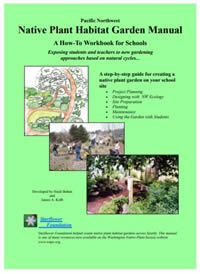I have become interested in helping with the conservation of monarch butterflies, whose caterpillars feed only on milkweed. We are supposed to plant milkweed. I am also gradually converting my small Seattle garden to a native-plant garden. Do these two goals contradict each other? Are any of the milkweeds native to Seattle and vicinity? Would monarchs themselves be an exotic species here?
It’s wonderful that you want to help with butterfly conservation. Monarch butterflies are not frequently seen in the Puget Sound region and, as you may be aware, it is too cold for them to overwinter here (they need an air temperature of at least 50 degrees Fahrenheit, according to Jerry Sedenko’s The Butterfly Garden [Villard Books, 1991]). However, you can do several things to make your home landscape hospitable to the pollinators we do have in our area, including not using any pesticides in your garden and persuading your friends and neighbors to refrain from using them also.
The Monarch Joint Venture project links to the Xerces Society’s Milkweeds: A Conservation Practitioner’s Guide which has information on milkweed species and their natural habitats. The plants recommended by the MJV for the West are Asclepias speciosa and Asclepias fascicularis but these plants may not be successful in the Puget Sound region. Both species are found mostly east of the Cascades as these maps from the USDA show. (click on the detail maps for Washington State)
The Xerces Society for Invertebrate Conservation has useful information(now archived) about Western Monarchs, as well as separate pollinator conservation resources (for different types of pollinators–not Monarchs) for the Pacific Northwest.
You might be most effective in supporting the Monarch conservation effort financially but devoting your gardening efforts to conservation of species that are native to our area. Here are the Xerces Society’s list of Pacific Northwest butterflies and bees.
The Puget Sound Beekeepers Association has information on bee-friendly gardening.
The issue of using native plants in our urban gardens is a complex one. How do we define the native status of a plant? Sometimes the only plants available in nurseries are cultivated varieties of native species: are they still ‘native?’ Are plants that have naturalized in our area native? Do we have the ideal conditions in our garden to sustain native plants?
My personal outlook on this is that it’s best not to think too rigidly about what is native and what is not, but instead to be vigilant about what is overly aggressive or definitively noxious and invasive, and to try to grow a diverse range of plants that will thrive without excessive watering, fertilizing, and fuss, and select plants (native and otherwise) will attract birds, beneficial insects, and local species of butterfly. Here is Washington State University Extension horticulturist Linda Chalker-Scott’s essay on the topic of native plants.
